The staff of the European Southern Observatory published a picturesque image obtained by the VLT Survey Telescope. It demonstrates the Gum 41 nebula.

The Gum 41 nebula is a classic example of the Strömgren sphere. It is a spherical shell of ionized hydrogen, which glows due to the powerful radiation of the star located in the center. More precisely, the stars. Although we see one very bright object, in fact it is a pair of two young massive luminaries. The distance between them is so small that it is impossible to distinguish them individually on the scale of such an image.
Gum 41 is part of a much larger region that is sometimes referred to as the Running Chicken Nebula. It is a region of active star formation located at a distance of 6,500 light-years from Earth in the direction of the constellation Centaurus.
This region is home to many pairs of newborn stars, including a bright object that can be seen on the lower right edge of the Gum 41 nebula. Already in the near future, on an astronomical scale, a tragic end awaits them. Unlike our Sun, which has a lifetime of about 10 billion years, the massive luminaries forming these pairs will last only a few million years. After their death, nebulae like Gum 41 will lose their illumination source and disappear forever.
Earlier we talked about how astronomers photographed a dark tower in space.
According to https://www.eso.org
Follow us on Twitter to get the most interesting space news in time
https://twitter.com/ust_magazine


